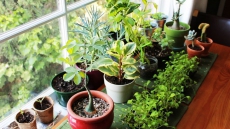In my experience, gardeners often overestimate rainfall. A cloudburst might seem to have thoroughly saturated the ground, but scratch down an inch and you might find bone-dry soil.
Because watering — not too much and not too little — is one of the keys to a successful garden, it pays to be more analytical about that cloudburst.
The amount of rain that fell, how long to water your plants, or how much water plants need is often spoken of in terms of inches. As a general rule, plants need about 1 inch of water per week to really thrive. It’s easily measured with a rain gauge, which you can either buy or make at home out of nothing more than a coffee or some other can, and a ruler.
Because I am the one with the rain gauge, my neighbor usually calls across the fence the morning after a night shower, “How many inches did we get?”
A rain gauge can tell you how long to use your sprinkler to put that inch of water onto the garden. Because the distribution of the water might not be uniform, set out a few cans at random over the area to be watered. Then turn on the spigot, and keep it on until the sprinklers have filled the cans with water 1 inch deep.
To cover an acre with water 1 inch deep requires about 27,000 gallons. On a garden of 150 square feet, an inch of water is equivalent to 90 gallons.
If you’re watering with a bucket or watering can, use the 1-inch measure to determine the amount needed for an individual plant. (It is especially important for newly planted trees and shrubs to be watered their first season.)
First, estimate the surface area — in bird’s-eye view — over which the roots spread. Usually this is assumed to be the same as the horizontal spread of the branches. The roots of a rose bush I planted this past spring, for example, probably now spread over a couple of square feet. Two square feet, or 288 square inches, times 1 inch depth equals 288 cubic inches, or about 5 quarts, of water.
The rule could also be translated this way: Each week, apply 2 1/2 quarts of water per square foot. With a watering can, it is easy to see how much water you are using. If you use a hose, compute its output over time, then figure out how long you have to stand there to get sufficient water for the area you are watering. It probably is longer than you expected.
This watering guideline applies to soil that has not dried out too much. If the soil is bone-dry because you haven’t watered or because it hasn’t rained for three weeks, you have to get it thoroughly wet first. Then, in a week, give that inch, or 2 1/2 quarts per square foot.
Also, this “inch” rule applies to plants whose roots are mostly in the upper foot of soil, which includes most annual vegetable and flower plants. Plants that root deeper than a foot need more water; corn roots, for example, run 3 feet deep.
Every gardener should have a rain gauge. Mechanical or computerized gauges will tell you the amount of rainfall (the depth, in inches) to the nearest hundredth of an inch. Even a straight-sided coffee can is probably accurate to an eighth of an inch.
A rain gauge will tell you if a summer shower dropped enough water that you can forget watering for a week, or if what you thought was a hard rain was just a piddling quarter-inch sprinkle. If you get only a quarter inch of rain, the remaining three-quarters of an inch, or couple of quarts of water per square foot, will have to come from your hose or watering can.






